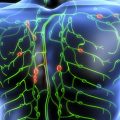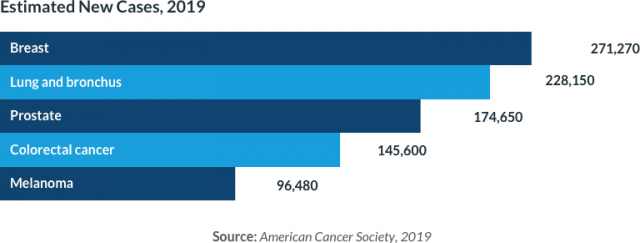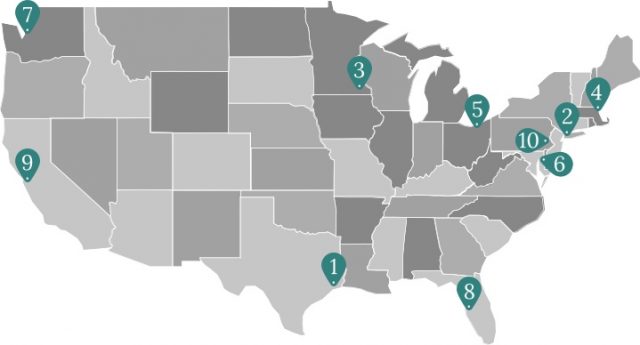Understanding Cancer
Despite recent advances in research and treatment, cancer remains the second leading cause of death in the United States. Doctors will diagnose an estimated 1.7 million cases of cancer in 2019, and more than 600,000 Americans will die from various cancers this year.

What Is Cancer?
Cancer refers to a collection of related diseases that share one characteristic: Abnormal cell growth. There are more than 100 types of cancer.
Our bodies contain approximately 37.2 trillion cells. As cells wear down and die, new cells take their place. Cancer forms when cells grow out of control and crowd out normal cells, causing problems in the part of the body where it started or spread.
How Does Cancer Spread?
Cancer cells can spread to other parts of the body through the bloodstream or lymphatic system. The spread of cancer is called metastasis.
- Bloodstream:
-
Cancer most often spreads through the bloodstream. Cancer cells can break away from the main tumor, travel through a blood vessel and move throughout the body. Many of these cells die, but some may settle in a distant organ and form new tumors.
- Lymphatic System:
-
The lymphatic system removes contaminants, such as viruses and bacteria, through bean-shaped filters called lymph nodes. Cancer can develop in the lymph nodes (lymphoma) or spread there from somewhere else in the body. Looking for metastasis to the lymph nodes is an important part of estimating a cancer’s stage.


Any cancer can spread, but how and where it spreads depends on the specific type of cancer.
- Lung cancer tends to spread to the brain, bones, liver and adrenal glands.
- Prostate cancer typically spreads to the bones.
- Breast cancer commonly spreads to the liver, lungs, bones and brain.
Cancer Staging
Cancer staging is the process of determining how much cancer is in the body and if the cancer has spread. The stage describes the severity of an individual’s cancer and often dictates available treatment options.
Staging is an important part of determining the prognosis, or outlook, for a specific patient. Each cancer has its own classification system. However, most cancers are staged on a scale from 1 to 4.
Stage 1 is the least advanced stage, when tumors are contained at the point of origin. By stage 4, the cancer has spread to distant parts of the body and is difficult to treat.
Types of Cancer
There are more than 100 types of cancer. They are usually named for the organs or tissues where they form. Most cancers fall under certain categories.
Five Major Cancer Categories
- Carcinoma
-
Starts in the cells that make up the skin or lining of organs. Accounts for 80 to 90 percent of all cancer cases.
Examples:
Breast, lung, colon and prostate cancer - Sarcoma
-
Originates in bone and connective tissues such as cartilage, muscle and tendons. Tumors usually resemble the tissues where they form.
Examples:
Osteosarcoma or osteogenic sarcoma (bone), angiosarcoma (blood vessels), mesothelioma (lining of body cavities) - Myeloma
-
Begins in the plasma cells of bone marrow.
Examples:
Multiple myeloma - Leukemia
-
Develops in the blood-forming tissue of the bone marrow. These don’t form solid tumors and are often called “blood cancers.”
Examples:
Myelogenous or granulocytic leukemia (overproduction of immature white blood cells) - Lymphoma
-
Solid cancers that start in the glands or nodes of the lymphatic system.
Examples:
Hodgkin lymphoma and Non-Hodgkin lymphoma
Source: National Cancer Institute, 2018
Cancers may also be grouped by where they develop. For example, thoracic cancers affect the thoracic cavity and include lung cancers, thymic malignancies and tracheal tumors.
Gastrointestinal cancers include cancers of the esophagus, liver, pancreas, stomach, intestines, pancreas and colon. Head and neck cancers often refer to malignancies of the throat, lips, mouth, larynx and salivary glands.
Most Common Cancers in U.S.
Estimated New Cases, 2019

Genetic vs. Preventable Cancers
Genetic mutations contribute to a person’s risk of developing certain cancers.
Everyone has some risk of developing cancer, but some people are genetically predisposed to developing certain types of malignancies. These are known as hereditary cancers.
For example, if breast cancer runs in your family, you have a higher risk of developing the disease than the general public.
Common Hereditary Cancers
- Breast
- Ovarian
- Colorectal
- Prostate
Other cancers are partly or almost entirely preventable. Non-inherited causes of cancer have a direct impact on your overall cancer risk.
Notable Preventable Cancers
- Cigarette smoking
-
Cigarette smoking is linked to about 80 to 90 percent of lung cancers.
- Alcohol
-
Heavy alcohol use increases the risk of liver cancer.
- Tobacco
-
Smoking and chewing tobacco increases the risk of oral cancer.
- Sunburn
-
Getting sunburned just once every two years triples your risk of melanoma skin cancer.
- Asbestos Exposure
-
Exposure to asbestos is the leading cause of mesothelioma.





Finding Resources
A cancer diagnosis can be devastating, but resources are available to help patients and their loved ones make the journey a little more manageable.
- Transportation
-
Depending on the type of cancer, patients may need to travel long distances to receive the best care.
- Organizations such as Air Charity Network provide free air transportation to specialized medical facilities and serve all 50 states.
- The American Cancer Society’s Road to Recovery Program offers free ground transportation to and from treatment.
- Angel Wheels to Healing provides long-distance ground transportation for financially disadvantaged patients.
- Lodging
-
Traveling for cancer treatment is expensive, and overnight stays typically aren’t covered by insurance.
- With more than 30 locations nationwide, the American Cancer Society’s Hope Lodge offers patients 18 and older and their caregivers a free place to stay when traveling for treatment. The organization also provides overnight accommodations to patients in a cooperative effort with hotels across the country.
- Joe’s House is a nonprofit organization that connects cancer patients and their loved ones with discounted lodging near cancer centers and hospitals.
- The Fisher House Foundation operates a network of houses where families of military veterans can stay for free while their loved one receives treatment.
- Financial Help
-
Financial burdens can take a toll on cancer patients and their caregivers. Thankfully, there are financial support resources available to help families cover costly treatments and other expenses.
- The Cancer Financial Assistance Coalition provides a searchable database of financial resources for patients nationwide.
- Nonprofits such as CancerCare provide financial assistance for cancer-related costs and copays.
- The American Cancer Society can direct people to local service organizations in their community.
- Support
-
Support comes in many forms. Emotional support is available for patients and their families online and in person.
- Cancer Support Community offers free support groups, educational sessions and health and wellness programs. It has more than 170 locations worldwide, including 46 licensed affiliates and health care partnerships.
- The American Cancer Society’s Cancer Survivors Network provides online discussion boards categorized by diagnosis and topic.
- Belong is the world’s largest social network for cancer patients, caregivers and health care professionals. The mobile app also gives users access to specialists to ask questions, a document management system and access to a clinical trial matching service.
Treatment Options
The most common treatments for cancer are surgery, chemotherapy and radiation therapy. However, emerging treatments such as immunotherapy are touted as the future of cancer treatment and are helping patients survive longer than ever.
-

Surgery
Aims to remove all visible tumors. This may mean removing part or all of an organ or tissue. Surgery is not used for blood cancers such as leukemia. -

Radiation Therapy
Uses high-energy waves to destroy or damage cancer cells. It can be used alone or in combination with chemotherapy and surgery. -

Chemotherapy
Kills cancer cells or slows their growth. Chemotherapy can be given through an IV or as a pill. -

Immunotherapy
Empowers your immune system to fight cancer. Immunotherapy drugs have been approved to treat various cancers, including lung cancer, melanoma and colorectal cancer.
Common Side Effects of Cancer Treatment
-
 Anemia (Low red blood cell count)
Anemia (Low red blood cell count) -
 Hair Loss
Hair Loss -
 Pain
Pain -
 Fatigue
Fatigue -
 Cognitive Impairment or “Chemo Brain”
Cognitive Impairment or “Chemo Brain” -
 Nausea/Vomiting
Nausea/Vomiting
Top Cancer Hospitals in the U.S.
- MD Anderson Cancer Center (Houston)
- Memorial Sloan Kettering Cancer Center (New York City)
- Mayo Clinic (Rochester, Minnesota)
- Dana-Farber/Brigham and Women’s Cancer Center (Boston)
- Cleveland Clinic
- Johns Hopkins Hospital (Baltimore)
- Seattle Cancer Care Alliance at University of Washington Medical Center
- H. Lee Moffitt Cancer Center (Tampa, Florida)
- UCSF Medical Center (San Francisco)
- Hospitals of the University of Pennsylvania-Penn Presbyterian (Philadelphia)

Cancer Disparities
Cancer affects each population differently. Minority groups and people with socioeconomic inequalities have higher cancer mortality rates compared to whites and those in better financial standing.
Race
Black Americans have the highest death rate and lowest survival rate of any racial or ethnic group for most cancers. However, the overall cancer death rate is dropping faster in blacks than in whites, especially in cases of lung, colorectal and prostate cancer.
5-Year Survival Rates by Race

Socioeconomic Gap for Cancer
While the racial gap in cancer mortality is slowly narrowing, people of lower socioeconomic status still bear a disproportionate share of the cancer burden.
The socioeconomic gap of cancer deaths widened significantly in the past three decades. Between 2012 and 2016, the overall cancer death rate was approximately 20% higher among residents of the poorest U.S. counties compared to the most affluent areas.
Minority groups in the U.S. are more likely to be poor and have little access to effective health care. Limited health care access is a major contributor to disparities.
Poor individuals are less likely to get recommended cancer screenings. Because of this, those below the poverty line are more likely to be diagnosed with a late-stage cancer, which limits effective treatment options.
Cancer Mortality Rate by Socioeconomic Status, 2012-16
| Poor | Affluent |
|---|---|
| 176.7 deaths per 100,000 | 149.7 deaths per 100,000 |
Researchers have also found a correlation between people of lower socioeconomic status and higher rates of behavioral risk factors of cancer, including:
- Tobacco use
- Physical inactivity
- Obesity
- Alcohol abuse
- Poor nutrition
- Lower rates of breastfeeding
- Exposure to environmental risk factors (exhaust, smog, chemicals)
Geographic Location
A 2017 report from the Centers for Disease Control and Prevention shows people who live in rural areas get cancer less often but die from it at higher rates compared to those in urban areas.
|
Overall Cancer Incidence Rate |
Cancer Death Rates |
|
|---|---|---|
|
Rural |
442 cases per 100,000 |
180 deaths per 100,000 |
|
Urban |
457 cases per 100,000 |
158 deaths per 100,000 |
Living with Cancer
Whether you are a patient or a caregiver, a cancer diagnosis can change your life forever. Treatments may go on for years. A diagnosis may change not only the patient’s quality of life, but their loved ones’ way of life.
Living with cancer means coping with stress, dealing with possible depression and learning how to overcome challenges — expected and unexpected — so you can focus on the moments and memories that matter most.
While geography alone can’t predict your risk of cancer, it can impact prevention, diagnosis and treatment opportunities — and that’s a significant public health problem in the U.S.
Coping with Stress
The American Society of Clinical Oncology says dealing with cancer is likely one of the most stressful life events for patients and caregivers. There are two kinds of cancer-related stress: Acute and chronic.
- Acute Stress: These initial stressful feelings after a diagnosis may include racing thoughts, sweating, fast heart rate, muscle tension and physical and emotional changes.
- Chronic Stress: If left unchecked, stress can become a long-term issue called chronic stress. This can negatively impact a patient’s immune system, sleep patterns, digestive and cardiovascular systems and emotional well-being.
Ways of Coping with Stress
The National Institute of Mental Health outlines some tips for coping with cancer-related stress.
- Recognize the Signs: Difficulty sleeping, being easily angered, feeling depressed, having low energy
- Get Regular Exercise: 30 minutes of walking per day can boost your mood and reduce stress
- Try a Relaxing Activity: Meditation, yoga, tai chi or gentle exercises
- Set Goals: Prioritize your daily tasks and learn when to say “no” to avoid feeling overloaded.
- Find Support: Stay connected with family and friends who are willing to help out. You can also seek help through community or religious organizations.
Dealing with Depression
Depression is more serious and long-lasting than stress. It is important to recognize the signs and seek help if you or your loved one has depression.
Signs of Depression
There are many signs of depression, and they vary from person to person. Some symptoms, such as weight changes, can be caused by the cancer itself or its treatments. But if the following symptoms happen nearly every day for several weeks, you should consult a mental health specialist.
- Thoughts of being worthless or hopeless
- Recurring thoughts of death or suicide
- Persistent low mood
- Excessive guilt
- Fatigue or lack or energy
- Poor concentration and decision making
Getting Help for Depression
There are many ways to treat depression. Treatment helps reduce suffering and improve quality of life.
- Lifestyle Changes: These are simple but may be all you need. Regular exercise, social support, well-balanced nutrition, getting enough sleep and managing stress can all improve symptoms of depression.
- Professional Help: Mental health professionals treat depression through cognitive behavioral therapy, interpersonal therapy and psychodynamic therapy. Mental Health America offers an online database of local mental health professionals and associations.
- Alternative and Complementary Treatments: Vitamins, supplements and relaxation techniques may help reduce symptoms of depression. Always consult your doctor before taking any new supplements.
- Medication: Antidepressant medications may help relieve symptoms of clinical depression, but these drugs also come with side effects and safety concerns. Consult your doctor and oncology team when deciding if antidepressants are right for you.
Overcoming Challenges of Cancer
People with cancer face a range of emotional and physical challenges. It is important to be aware of these challenges and know how to manage them.
- Hair Loss
-
Problem: Hair loss, or alopecia, is a common side effect of chemotherapy. Hair loss tends to increase one to two months into treatment, and hair starts to regrow one to three months after chemotherapy ends.
Help: Cold cap therapy, also known as scalp cryotherapy, can help prevent hair loss. Nonprofit organization Lolly’s Locks provides high-quality stylized wigs free of charge to cancer patients who otherwise can’t afford them.
- Nutrition
-
Problem: A nutritious diet is essential for cancer patients, but these diseases and their treatments can make it difficult for patients to meet their nutrition needs. Food can taste horrible; nausea may come and go; and appetites can be inconsistent. This can lead to unintentional weight loss.
Help: The Academy of Nutrition and Dietetics can help cancer patients learn more about proper nutrition and find a registered dietitian.
- Costs
-
Problem: Even with a good insurance policy, cancer treatment can cost thousands of dollars in deductibles and copays. Cancer patients are more than twice as likely to declare bankruptcy as healthy people, according to AARP.
Help: The American Society of Clinical Oncology offers a directory of financial assistance resources for cancer patients and their families.



Surviving Cancer
Cancer doesn’t have to be a death sentence. Cancer death rates have fallen significantly in the last 15 years. Much of this is attributed to steady declines in the four most common cancer types — lung, colorectal, breast and prostate.
Healthier lifestyle habits, such as a reduction in smoking and improvements in early detection, have powered recent progress against cancer.
Survival rates have also increased substantially in recent decades thanks to improved treatment options and emerging therapies such as immunotherapy.
The 5-year relative survival rate for all cancers is roughly 70%. In the early 1960s, it was just 39%.
Resources are available to help patients and their families in their fight against this disease. Doctors and researchers at the nation’s top cancer centers are closing in on the next breakthrough treatment.

